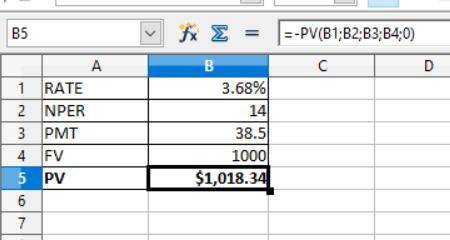
Business, 30.07.2020 04:01 evsdcp44b3w
Suppose a seven-year, $ 1 comma 000$1,000 bond with aa 7.7 %7.7% coupon rate and semiannual coupons is trading with a yield to maturity of 6.45 %6.45%. a. Is this bond currently trading at a discount, at par, or at a premium? Explain. b. If the yield to maturity of the bond rises to 7.36 %7.36% (APR with semiannual compounding), what price will the bond trade for?

Answers: 3
Another question on Business

Business, 22.06.2019 04:50
Problem 9-5. net present value and taxes [lo 1, 2] penguin productions is evaluating a film project. the president of penguin estimates that the film will cost $20,000,000 to produce. in its first year, the film is expected to generate $16,500,000 in net revenue, after which the film will be released to video. video is expected to generate $10,000,000 in net revenue in its first year, $2,500,000 in its second year, and $1,000,000 in its third year. for tax purposes, amortization of the cost of the film will be $12,000,000 in year 1 and $8,000,000 in year 2. the company’s tax rate is 35 percent, and the company requires a 12 percent rate of return on its films. required what is the net present value of the film project? to simplify, assume that all outlays to produce the film occur at time 0. should the company produce the film?
Answers: 2

Business, 22.06.2019 19:40
Anita has been named ceo of a popular sports apparel company. as ceo, she is tasked with setting the firm's corporate strategy. which of the following decisions is anita most likely to makea) whether to pursue a differentiation or cost leadership strategy b) which customer segments to target c) how to achieve the highest levels of customer satisfaction d) what range of products the firm should offer
Answers: 2

Business, 23.06.2019 00:00
1. consider a two-firm industry. firm 1 (the incumbent) chooses a level of output qı. firm 2 (the potential entrant) observes qı and then chooses its level of output q2. the demand for the product is p 100 q, where q is the total output sold by the two firms which equals qi +q2. assume that the marginal cost of each firm is zero. a) find the subgame perfect equilibrium levels of qi and q2 keeping in mind that firm 1 chooses qi first and firm 2 observes qi and chooses its q2. find the profits of the two firms-n1 and t2- in the subgame perfect equilibrium. how do these numbers differ from the cournot equilibrium? b) for what level of qi would firm 2 be deterred from entering? would a rational firm 1 have an incentive to choose this level of qi? which entry condition does this market have: blockaded, deterred, or accommodated? now suppose that firm 2 has to incur a fixed cost of entry, f> 0. c) for what values of f will entry be blockaded? d) find out the entry deterring level of q, denoted by q1', a expression for firm l's profit, when entry is deterred, as a function of f. for what values of f would firm 1 use an entry deterring strategy?
Answers: 3

Business, 23.06.2019 01:10
Hillside issues $4,000,000 of 6%, 15-year bonds dated january 1, 2016, that pay interest semiannually on june 30 and december 31. the bonds are issued at a price of $4,895,980. required: 1. prepare the january 1, 2016, journal entry to record the bonds’ issuance
Answers: 3
You know the right answer?
Suppose a seven-year, $ 1 comma 000$1,000 bond with aa 7.7 %7.7% coupon rate and semiannual coupons...
Questions

Mathematics, 13.02.2021 15:20


Mathematics, 13.02.2021 15:20





Computers and Technology, 13.02.2021 15:20


Social Studies, 13.02.2021 15:20



Health, 13.02.2021 15:30


Mathematics, 13.02.2021 15:30




English, 13.02.2021 15:30





